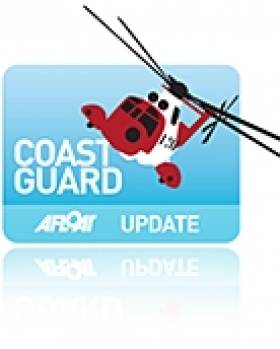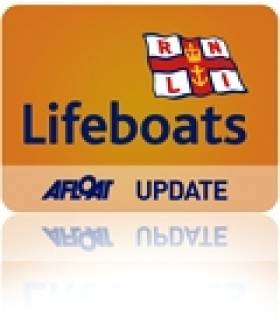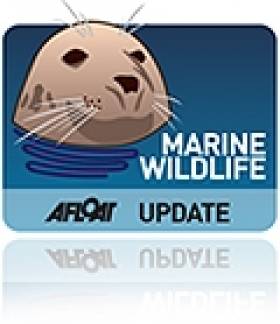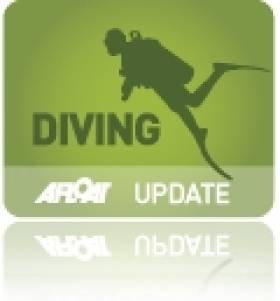Displaying items by tag: Radio
RTÉ's Mooney Show Checks In With Howth Coast Guard
#Coastguard - RTÉ presenter Mary Kingston recently paid a visit to Howth Coast Guard for Radio 1's The Mooney Show as they patrolled Dublin Bay.
Among the people they met along the way were a couple who sprang into action after seeing a man face down in the water off the seafront at Clontarf in North Dublin.
The RTÉ website has the segment from 30 July's Mooney Show available to listen HERE.
#RNLI - Enniskillen RNLI will host the revived Castle Island charity swim and family fun morning in Enniskillen, Co Fermanagh on Sunday 11 August.
The swim traditionally took place each year with the support of the Blake family.
And Enniskillen RNLI have hailed as a "great honour" the opportunity for its local volunteer crew to revive the swim in association with sponsors Blakes the Hollow, Western Cars and The Print Factory.
The 750m swim on Lough Erne is open to swimmers of all ages either individually or in small groups such as youth clubs, sports clubs or simply groups of friends.
Enniskillen RNLI says the emphasis for this swim is for everyone to have fun and for that reason, if required, novice swimmers may complete the swim in a well-fitted lifejacket or buoyancy aid but must be confident that they can complete the distance.
Lifeboat crew not swimming themselves will also be present on the day to provide safety cover for the event.
Registration for the swim will take place at 12 noon on the day, followed by a short safety briefing. Sponsorship forms are available by email or can be collected at The Wig & Crown, Blakes the Hollow and Western Cars. For further information contact Adrian at 07974 730456.
In other news, RTÉ Radio 1’s The Business will broadcast live from Bundoran RNLI lifeboat station this Saturday morning 3 August.
The focus of the show will be on the business of Bundoran being a seaside resort - a reputation the Donegal town has enjoyed for more than two centuries.
Speaking ahead of his visit, programme host George Lee said: "I'm really looking forward to broadcasting from Bundoran, particularly on a bank holiday weekend. I'm hoping to experience lots of surfing, slots machines and ice-creams.
"On the show we'll be looking back at the heyday of the dancehalls, we'll be joined by Bundoran regular Ramona Nicholas from Dragon's Den, we'll be speaking to two men making money from oil exploration and lots, lots more."
The Business is broadcast Saturday morning at 10am on RTÉ Radio 1.
#Surfing - Two national broadcasters will base themselves in Bundoran this week ahead of the Sea Sessions Surf Music Festival at the weekend.
Today FM’s KC Show will broadcast live from the Bundoran RNLI Lifeboat Station tomorrow 19 June and Thursday 20 June, while 2FM will broadcast from the Sea Sessions from Friday 21 to Sunday 23 June, giving the seaside town unprecedented national media coverage for five days.
As part of a recent Discover Ireland promotion on Today FM, listeners were asked where to send the various shows to on their holidays. Listeners to the KC Show had a choice of sending him to Dingle or Donegal and following thousands of votes, Donegal came out on top.
One of the locations suggested was Bundoran, and the RNLI Lifeboat station at the pier was chosen as the home for the KC Show for two daily broadcasts this week complete with live musical guests Walking With Cars and new Irish act Daithi.
No sooner will Today FM have packed up than the 2FM Roadcaster will be rolling into the Main Beach car park and preparing to broadcast from the Sea Sessions on Friday, Saturday and Sunday.
The national state broadcaster will give the festival unprecedented coverage with over 20 hours scheduled live from the beachfront. Jenny Greene, Cormac Battle, Ruth Scott and Paddy McKenna will all host their shows live across the weekend.
Bundoran tourism officer Shane Smyth commented: "I am thrilled that not one but two national broadcasters will be in town this week. It will be a welcome boost to the ongoing promotion of Bundoran as a destination.
"Speaking as Bundoran RNLI volunteer lifeboat press officer also, I’m obviously delighted that the RNLI will benefit from two days of national coverage and I know that KC and his team are keen to find out more about the lifeboat service here in Bundoran."
Smyth added: "The guys from 2FM had a great time when they were here a few weeks ago and we look forward to welcoming them again over Sea Sessions weekend. Last time they were here they brought scorching sunshine with them – let’s hope they do the same again!”
Sea Sessions is Ireland's "biggest and best" surfing and music festival and returns for its sixth successive year in 2013. Based in Bundoran, the festival also includes surf tour events in Lahinch, Co Clare and nearby Sligo.
Shannon's First Recorded Dolphin Spotted Again 20 Years On
#MarineWildlife - The 21st year of dolphin research in the Shannon Estuary is off to an amazing start after the first ever dolphin recorded in the estuary was spotted on the Kerry coast.
As the Shannon Dolphin and Wildlife Foundation (SDWF) reports, the dolphin known as 'No 1' was sighted in Brandon Bay on Saturday 25 May swimming in a group of three.
No 1 is happily a familiar sight in the region, having been recorded most years since the project began in 1993.
"It has long been known that Shannon dolphins regularly use Tralee and Brandon Bays but how important the area is in not clear," says the SDWF on its blog. "If we are to protect the Shannon dolphins we need to ensure we identify all their important habitats and extend protection to these areas if necessary."
Meanwhile, its been confirmed that the trio of bottlenose dolphins who took up residence near Bunratty Castle in the spring have been observed in the mainstream of the Shannon Estuary.
The three were spotted on the first monitoring trip of the summer from Kilrush last week by SDWF researchers of Moneypoint.
"This demonstrates again the value of long term monitoring and the power of a photo ID catalogue to monitor the Shannon dolphins," says the SDWF blog.
In other cetacean news, an in-depth discussion of the Shannon's dolphins and the Irish Whale and Dolphin Group's (IWDG) research of bottlenose dolphins around the Irish coastline was broadcast on Derek Mooney's afternoon show on RTÉ Radio 1 recently.
A podcast of the 30-minute segment of Mooney Goes Wild from Friday 31 May is available to download HERE.
On the Radio: Trailing The Fin Whale
#MarineWildlife - Tonight's Nature on One on RTÉ Radio 1 joins the Irish Whale and Dolphin Group (IWDG) on a quest off Hook Head to find the majestic fin whale.
As TEN reports, Colin Stafford Jones was on board with the IEDG's Pádraig Whooley on a mission to track down the world's second largest animal - not only the biggest example of marine wildlife behind the incredible blue whale.
Their adventure will be broadcast tonight (Sunday 9 June) from 7pm on RTÉ Radio 1, and will be available to listen online afterwards via the Nature on One website HERE.
New RnaG Radio Series on Galway Bay Fishing Industry
#FISHING - A new radio series on developments in Galway's fishing industry is part of the new autumn schedule on Raidió na Gaeltachta.
As the Galway Advertiser reports, Ballach, Bradán agus Bairneach is funded through the Broadcasting Authority of Ireland's Sound and Vision scheme and will cover the changes experienced in fishing in Galway Bay from Famine times till the present day.
Topics to be covered on the seven-part series, presented by former RnaG station head Tomás Mac Con Iomaire, include traditional fishing methods and classic fishing boats, the establishment of Bord Iascaigh Mhara (BIM), the effects of European fisheries policy, and contemporary developments such as fish farming that have prompted some recent controversy.
Ballach, Bradán agus Bairneach will be broadcast Saturdays at 6.30 pm, with the first programme tonight 15 September focusing on fishing in olden times and the folklore surrounding it. Link to the show here.
Irish Free Diver Pushes The Limits of The Human Body
#DIVING - An Irish free diver has told the Irish Examiner how he plunged the equivalent of a 15-storey building beneath the surface of the Red Sea on a single held breath.
Fergus Callagy's breathtaking feat is a highlight of a radio documentary about his extraordinary pastime, Fire and Water, which is available to listen on the RTÉ Radio 1 website.
The Sligo man - who says he can hold his breath for more than five minutes at a time - also recounts how he stunned experts at Sligo General Hospital by slowing his heart rate to an incredible 25 beats per minute - less than half the normal resting heart rate.
"It has been described as the most relaxing extreme sport," says Callagy of free diving, of which he is a leading light in Ireland. "When I got into [it] I started to admire what the human body can do."
The Irish Examiner has more on the story HERE.
#MARINE NOTICE - The latest Marine Notice from the Department of Transport, Tourism and Sport (DTTAS) reminds mariners to familiarise themselves with the operation of the distress alert button on GMDSS marine radio equipment.
Radio communications fitted on board Irish ships and fishing vessels with distress button capability, such as DSC or GMDSS-compliant satellite terminals, are fitted with a distress button which initiates an automatic distress alert on maritime mobile distress frequencies. This includes the identification of the vessel and may include its position.
The Maritime Radio Affairs Unit wishes to bring to the attention of GMDSS marine radio operators the Guidance on Distress Alerts contained in the IMO Circular COMSAR.1/Circ.45 which can be found HERE.
Owners and operators should ensure that this notice is posted at all VHF, MF, HF, DSC Digital Selective Calling and all GMDSS approved maritime satellite communications equipment.
Complete details for shipowners, fishing vessel owners, shipmasters and seafarers are included in Marine Notice No 36 of 2012, a PDF of which is available to read and download HERE.
#MCIB - The families of two fishermen found dead at sea off the Skerries last April may never uncover the circumstances that led to their demise. But the official report into the incident indicated that the absence of lifejackets was a significant contributing factor.
Ronan Browne (26) and David Gilsenan (41) were reported missing on the evening of 1 April after failing to return from a trip tending to lobster pots.
Their vessel, Lady Linda, was found the following morning upturned in an oil slick off Clogherhead with no sign of the crew.
It wasn't until a week later that their bodies were discovered caught in the vessel's fishing gear some five miles east of Clogherhead, as previously reported on Afloat.ie.
Post-mortem results found that both men died from drowning, with Gilsenan also showing signs of hypothermia.
With no eyewitnesses to the incident, the report by the Marine Casualty Investigation Board (MCIB) indicated a number of possible causes from eqiupment malfunction or shifting of lobster pots on deck, to the wave height and weather conditions on the day, which were reportedly deteriorating when the boat left port.
It also said that Browne and Gilsenan "were lifelong friends, both men were experienced and qualified marine engineers in the fishing vessel industry. Both men were experienced in boat handling and fishing and had worked together on many occasions."
But the report emphasised the lack of personal flotation devices (PFDs) on board, and noted that emergency equipment was stored under the deck and not easily accessible.
The MCIB's recommendations include a review of the code of practice for fishing vessels under 15m to establish "revised stability critera" and ensuring that all boats are fitted with automatic radio beacons that deploy upon capsize.
In a separate incident, lack of proper maintenance led to an unlicenced boat taking on water off Co Kerry last August.
The Claire Buoyant was carrying one crew, five passengers and 21 sheep from Beginish Island to Ventry when the vessel began to lose stability.
Skipper Eoin Firtear - who the MCIB described as having "limited sea-going experience" - and his five passengers were rescued by passenger ferry. All sheep were jettisoned overboard, with 18 eventually recovered.
The report reminded that the carriage of livestock should only be undertaken in appropriately certified vessels.
- MCIB
- Marine Casualty Investigation Board
- report
- Lady Linda
- Clogherhead
- Ronan Browne
- David Gilsenan
- lobster pots
- Fishing
- drowning
- hypothermia
- missing
- malfunction
- wave height
- Weather
- lifejackets
- Personal Flotation Devices
- PFDs
- Code of Practice
- stability
- Radio
- beacon
- maintenance
- unlicenced
- Co Kerry
- Claire Buoyant
- Sheep
- Passengers
- Beginish Island
- Ventry
- Eoin Firtear
- Skipper
- Rescue
- Livestock
Marine Notice on Pipeline Survey in Celtic Sea
#NEWS UPDATE - The latest Marine Notice from the Department of Transport, Tourism and Sport (DTTAS) advises on a pipeline survey in the Celtic Sea next month.
PSE Kinsale Energy Limited will be commencing the survey of the 24" Gas Export Pipeline on 6 March 2012 using the Marine Institute vessel RV Celtic Voyager (call sign EIQN). The survey is expected to last 1 to 2 days, depending on weather conditions.
The survey will take place along the existing pipeline route in the Celtic Sea, between the shoreline at Inch Beach in Co Cork and gas platform 'Alpha'.
The RV Celtic Voyager will display appropriate lights and signals, and will be towing side scan sonar with cables of up to 200m long. A Radio Navigation Warning will be issued via the Irish Coast Guard (schedule Bravo, four times a day) prior to the vessel's arrival at the survey area. The vessel will also keep a listening watch on VHF Channel 16.
All vessels, particularly those engaged in fishing, are requested to give the RV Celtic Voyager and her towed equipment a wide berth and keep a sharp lookout in the relevant areas.
Further details for seafarers, including relevant co-ordinates, are included in Marine Notice No 7 of 2012, a PDF of which is available to read and download HERE.






































































